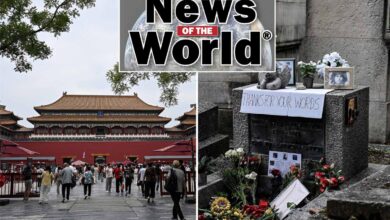How Mount Rushmore really came to be


Set in the Black Hills of South Dakota, Mount Rushmore may be one of the United States’ most recognizable landmarks, but as author Matthew Davis explains in “A Biography of a Mountain – The Making and Meaning of Mount Rushmore” (St. Martin’s Press), there’s a lot that most Americans don’t realize about it.
“I don’t think that your average American knows who created Mount Rushmore,” Davis told The Post.
State historian Doane Robinson commissioned sculptor Gutzon Borglum to create the monument in August 1925.
The son of Danish immigrants, Borglum was known not just for his artistic flair but also for his volatility and stubbornness. “He had insatiable vision and creativity, energy to spare,” writes Davis. But “by all accounts he was abusive, flippant, and dismissive, often blaming others for any mishaps on the mountain.”
Mount Rushmore wasn’t really his idea.
Robinson conceived the original concept in a bid to boost tourism. As it sits in the sacred land of the Lakota Sioux Nation in the Black Hills of South Dakota, he originally had the idea to carve image of fabled Lakota leader Red Cloud into the granite, not the four presidents.
Other figures considered, as a nod to the history of the American West, included explorers Lewis and Clark and frontier showman Buffalo Bill Cody.
Borglum had his own ideas.
Preferring something bolder and national in scope, he envisaged 200-feet high faces of George Washington and Abraham Lincoln but later added Thomas Jefferson and Theodore Roosevelt to create a “Shrine of Democracy” commemorating the founding, expansion, preservation and unification of the country.
Using miniature models and larger maquettes of the faces, Borglum scaled up his designs before setting to work.
The fact that two of the presidents lived during a time of photography meant that their representations were more lively and life-like.
“Whereas Washington and Jefferson are clean-shaven and resolute, their thin lips pursed in the ways of portraiture (perhaps to hide wooden teeth), both Lincoln and Roosevelt display thicker, more human lips and distinctive details,” writes Davis.
The project was a colossal undertaking. Over 400 men worked on the mountain, hanging from harnesses on the rock face and, if that wasn’t risky enough, tasked with planting a total of 225 tons of dynamite to remove over 450,000 tons of rock.
Despite the dangerous conditions, there wasn’t a single fatality in the construction.
Borglum died unexpectedly in March of 1941, at age 73, following complications from a surgery.
His son, Lincoln, who had worked on the project since he was a teenager, took over. Mount Rushmore was officially declared complete on Oct. 31, 1941.
Yet, the project wasn’t just a triumph of art and engineering.
Borglum had some disturbing views.
In the 1920s, while working on Stone Mountain in Georgia, he designed a memorial of Confederate leaders Jefferson Davis, Robert E. Lee and Thomas “Stonewall” Jackson surrounded by Ku Klux Klan members at an altar. He later became deeply involved in Klan politics, attending rallies and connecting its leaders with national figures.
As Davis notes, Mount Rushmore remains silent about Borglum’s troubling decadelong association with the Klan. “It would be uncouth to have America’s National Memorial carved by a man sympathetic to the Ku Klux Klan, but that, ultimately, is the reality.”
It’s not the only awkward truth about the landmark.
In 1868, The Black Hills, where Mount Rushmore stands, were guaranteed to the Lakota Sioux Nation in the Treaty of Fort Laramie, but later appropriated by the US government following the discovery of gold in the area in the 1870s.
Despite legal challenges, still ongoing, the Lakota Sioux Nation never got their sacred land back.
Indeed, the memorial’s first Native American superintendent, Gerard Baker, who served from 2004–2009, believed the full history of Mount Rushmore should make visitors uncomfortable.
“What do the visitors want to hear when they come to a park like Rushmore? And how do they want to leave?” he asks the author. “Well, most people want to come to a national park and leave with that warm, fuzzy feeling with an ice cream cone.
Today, over 2 million people visit Mount Rushmore every year and the landmark’s meaning has taken on a new life, especially in the digital age. “Every morning I get a Google Alert for Mount Rushmore, and nine times out of ten it will be the ‘Mount Rushmore of Philly cheesesteaks’ or the ‘Mount Rushmore of Clemson football players’ or something similar,” says Davis.
“On the one hand, I think Borglum would have loved that Mount Rushmore has become shorthand for greatness.
“On the other, he would have worried it cheapens his creation.”
There is also the possibility that the current incumbent of the White House may want to include a new figure, although Davis doesn’t think it will happen. “I don’t think we will ever see another face on Mount Rushmore as most experts believe there is no space to carve another,” he says.
This Article was copied from nypost .com, visit to read more
NOTE: THIS SITE DOES NOT BELONG TO FACEBOOK





